Let’s learn more about E-Commerce. The emergence of the Internet throughout the world has been contributing such a variety medium in doing business as well as people lifestyle. In fact, Internet is the essential prerequisite for the existence of E-commerce. It primarily involves transactions that cross firm boundaries. E-business primarily involves the application of digital technologies to business processes within the firm.
Electronic commerce or e-commerce is the ability to perform transactions involving the exchange of goods or services between two or more parties using electronic tools and technique. The explosion of E-commerce has created new phenomena in our lifestyle especially in shopping activities. Consumers can easily buy products or services like magazines and airlines tickets via Internet.
E-commerce is the new, profitable way to conduct business which goes beyond the simple movement of information and expands electronic transactions from point-of-sale requirements, determination and production scheduling, right through to invoicing, payment and receipt. E-commerce uses key standards and technologies including Electronic Data Interchange (EDI), Technical Data Interchange (TDI), Hypertext Mark-up Language (HTML), Extensible Mark-up Language (XML), and the Standard for Exchange of Product model data (STEP). E-commerce is made possible through the expanded technologies of the Internet, the World Wide Web, and Value-Added Networks.
Business Models
- B2B (Business to Business) – In a B2B transaction, the interaction is between businesses. For example, a website that is catching for the steel industry might have facility for buyers and sellers to list their requirements and post their products. It helps them in quickly closing the transactions and the buyer can get quality, material and can choose from different suppliers.
- B2C (Business to Consumer) – B2C e-commerce involves selling of goods and services to consumers or end users. It allows them to browse the product catalogue, select products or services and complete the order online. In a B2C transaction, the interaction is between a consumer and the preferred business. For example, the most popular site is flipkart.com, which started as an online bookseller and has branched to various other products, is now a potential competitor to the traditional sellers.
- Consumer-to-Consumer (C2C) – Consumer-to-Consumer (C2C) e-commerce provides a way for consumers to sell to each other, with the help of an online market or online listing websites such as the auction website eBay or product listing website like OLX or Quickr. In C2C e-commerce, the consumer prepares the product for market, places the product for auction or sale, and relies on the online market or online listing websites to provide catalog, search engine, and transaction-clearing capabilities so that products can be easily displayed, discovered, and paid for.
SCM and E-commerce
Over the years, e-commerce has been playing an increasing role in supply chain management. Taking advantage of e-commerce can allow a business to reduce processes and costs as well as to open distribution channels.
- Information Source – Businesses can use e-commerce to provide customers with product and related information in a timely and efficient manner. It can be useful in providing news, updates, instructions and upgrades.
- Distribution – E-commerce provides businesses with a new distribution channel to get products to the end users. E-commerce can also be used to reduce the number of layers between the company and its customers. It allows for a business to sell directly to its target market, reducing costs and increasing efficiency.
- Inventory – Inventory management is simplified through reporting systems connected to the shopping cart software and allows for businesses to carry more items than with a brick-and-mortar store. E-commerce also allows for additional efficiency with just-in-time inventory processes or print-on-demand.
E-commerce does not just mean trading and shopping on the Internet. It means business efficiency at all operation levels. The SCM is the backbone of Ecommerce, a very critical component of E-commerce. Supply Chain efficiency means having the right product at the right place at the right time, can save money/reduce costs, and can enhance cash utilization. A significant number of companies in the United States have implemented their internet platform for supply chain efficiency in the past 2 to 3 years, and the large of them will follow in the next years.



